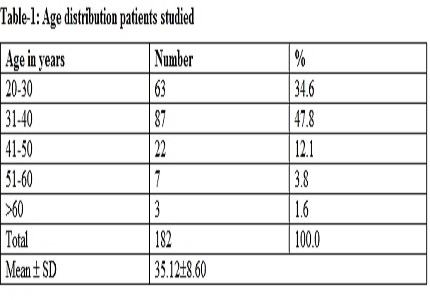Comparison and correlation of ophthalmic and systemic manifestations with respect to CD4 counts in HIV infected adults
Abstract
Purpose: To compare and correlate ophthalmic and systemic manifestations with respect to CD4 counts in HIV infected adults.
Materials and Methods: In a prospective clinical study, 182 HIV positive patients were evaluated for their ophthalmic findings. All patients underwent complete ophthalmic examination including detailed history, best corrected visual acuity, slit lamp examination, indirect ophthalmoloscopy and +90D lens biomicroscopy. Fundus photographs were taken in patients with ocular manifestations. Routine blood tests including total and differential count, Hb levels, erythrocyte sedimentation rate, erythrocyte and platelet counts were done. Serologic tests (ELISA for IgM antibody) for toxoplasma, cytomegalovirus was done in clinically suspicious cases. VDRL, and chest x-ray was performed in cases suspected to have syphilis and tuberculosis respectively.
Results: 182 patients were examined, 65.9% male and 34.1% being female patients. Most common systemic manifestation was pulmonary TB (39.1%) (p <0.001), second common being oral candidiasis (16.5%) (p <0.001) followed by abdominal TB (15.5%). Also, 37.9% patients had ocular lesions out of which 15.4% had HIV retinopathy, second common was CMV retinitis(9.3%) followed by HIV optic neuropathy(3.8%). 34.1% had CD4<100, 44% between 01-100 and 22% had CD4 >200. . Twenty five % of patients with pulmonary TB had HIV retinopathy and 12% with pulmonary TB had CMV retinitis. Among the 30 oral candidiasis patients 8(26.6%) developed HIV retinopathy, where as 10% developed CMV retinitis. Fifty seven % of patients with HIV retinopathy had CD4<100, 28.6% with CD4 between 101-200 and 14.3% with CD4 >200. Similarly 47.1% with CMV retinitis had CD4 <100, 52.9% had CD4 101-200. None with CD4 >200 developed CMV retinitis.
Conclusions: Study shows an increased prevalence of systemic diseases along with ocular diseases with decreased CD4 counts, particularly <100. Pulmonary TB is seen more frequently with CD4<200 and is also seen to be associated increasingly with ocular manifestations and more so when CD4 <100.
Downloads
References
Sarraf D, Ernest JT.AIDS and the Eyes. The Lancet 1996; 348(9026):525-28. DOI: http://dx.doi.org/10.1016/S0140-6736(05)65389-5.
Holland G.N, Gottlieb M.S, Yee RD et al. Ocular disorders associated with a new severe acquired cellular Immunodeficiency Syndrome. Am J Ophthalmol 1982; 93(4):393 - 402.
Biswas J, Madhavan HN, Badrinath SS. Ocular lesions in AIDS: a report of first two cases in India. Indian J Ophthalmol. 1995 Jun;43(2):69-72.
Cunningham ET Jr, Margolis TP. Ocular manifestations of HIV infection. N Engl J Med. 1998 Jul 23;339(4):236-44.
Turner B J, Hect FM, Ismail RB. CD4+ T Lymphocyte measures in the treatment of individuals infected with Human Immunodeficiency Virus type 1: A review for clinical practitioners. Arch Intern Med 1994(14); 154:1561-73. doi: https://doi.org/10.1001/archinte.1994.00420140022004.
Collier AC, Coombs RW, Schoenfeld DA, Bassett RL, Timpone J, Baruch A, Jones M, Facey K, Whitacre C, McAuliffe VJ, Friedman HM, Merigan TC, Reichman RC, Hooper C, Corey L. Treatment of human immunodeficiency virus infection with saquinavir, zidovudine, and zalcitabine. AIDS Clinical Trials Group. N Engl J Med. 1996 Apr 18;334(16):1011-7.
Hammer SM, Squires KE, Hughes MD, Grimes JM, Demeter LM, Currier JS, Eron JJ Jr, Feinberg JE, Balfour HH Jr, Deyton LR, Chodakewitz JA, Fischl MA. A controlled trial of two nucleoside analogues plus indinavir in persons with human immunodeficiency virus infection and CD4 cell counts of 200 per cubic millimeter or less. AIDS Clinical Trials Group 320 Study Team. N Engl J Med. 1997 Sep 11;337(11):725-33.
J.Brian Reed, M.D, Ivan R, Schwab, MD, et al. Regression of Cytomegalovirus retinitis associated with Protease-inhibitor treatment in patients with AIDS. Am J Ophthalmology 1997; 124(2):199-205. doi: https://doi.org/10.1016/S0002-9394(14)70784-6.
Rao NA. Acquired Immunodeficiency Syndrome and its ocular complications. Indian J Ophthalmology 1994;42(2): 51-63.
Kumarasamy N, Solomon S, Jayaker Paul SA, Venilla R, Amalraj RE. Spectrum of opportunistic infections among AIDS patients in Tamil Nadu, India. Int J STD AIDS. 1995 Nov-Dec;6(6):447-9.
Biswas JB, Joseph A, Raizada S, Kumarsamy. N, Solomon S. Ophthalmic manifestations of Human Immunodeficiency Virus (HIV) infection in India. Indian J. Ophthalmol 1999; 47(2):87-93.
Beare NA, Kublin JG, Lewis DK, Schijffelen MJ, Peters RP, Joaki G, Kumwenda J, Zijlstra EE. Ocular disease in patients with tuberculosis and HIV presenting with fever in Africa. Br J Ophthalmol. 2002 Oct;86(10):1076-9.
Biswas J, Madhavan HN, George A E, et al. Ocular lesions associated with HIV infection in India: A series of 100 consecutive patients evaluated at a referral centre. Am J ophthalmol 2000;129(1): 9-15.
Rushwurm ID, Kiss B, Rainer G, et al. Ocular blood flow in patients infected with Human Immunodeficiency Virus. Am J Ophthalmol 2001; 132(5):720-26. doi: https://doi.org/10.1016/S0002-9394(01)01095-9.
Engstrom RE Jr, Holland GN, Hardy WD, Meiselman HJ. Hemorrhologic abnormalities in patients with Human Immuno Deficiency Virus and ophthalmic Microvasculopathy. Am J Ophthalmol 1990;109(2): 153-61.
Rebecca F Sison, Gary N Holland et al. Cytomegalovirus retinopathy as the initial manifestation of the acquired immunodeficiency syndrome. American J Ophthalmology 1991;112(3): 243-249. DOI: http://dx.doi.org/10.1016/S0002-9394(14)76724-8.
Kuppermann B D, John G Petty et al. Correlation between CD4+ counts and prevalence of cytomegalovirus retinitis and human immunodeficiency virus-related noninfectious retinal vasculopathy in patients with acquired immunodeficiency syndrome. American J Ophthalmology May 1993;115(5): 575-582.



 OAI - Open Archives Initiative
OAI - Open Archives Initiative


